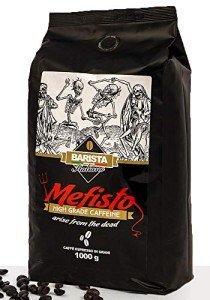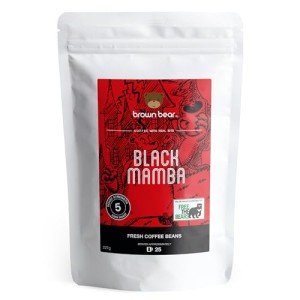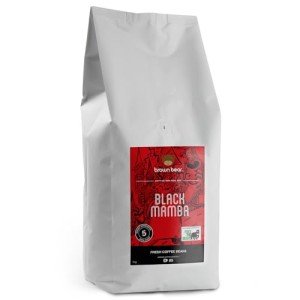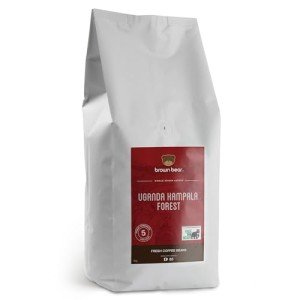Robusta coffee beans pack a punch with their bold flavor and rich, earthy notes. These beans have a higher caffeine content, making them a fantastic choice for a strong cup of coffee that gets you going. If you love deep, intense brews or want a little extra kick in your morning routine, look no further than robusta beans.
Robusta Coffee Beans
Discover the bold flavors and rich aromas that make Robusta coffee a favorite for espresso lovers
Product List

Devil's Roast Strong Espresso
Black Donkey
Product Review Score
4.2 out of 5 stars
215 reviews$23.66

Mefisto Dark Roast Espresso
Baristaitaliano Uk
Product Review Score
4.42 out of 5 stars
215 reviews$23.66



Bold Vietnamese Robusta Beans
Brown Bear
Product Review Score
4.67 out of 5 stars
110 reviews$24.97


Carraro Intenso Robusta Beans
Carraro 1927
Product Review Score
4.27 out of 5 stars
43 reviews$19.72 $16.77


Bold 100% Robusta Coffee - 250g
Very Strong Coffee
Product Review Score
4.58 out of 5 stars
190 reviews$13.14

Xtreme Strong Italian Coffee
Kiqo Coffee & Tea
Product Review Score
4.96 out of 5 stars
44 reviews$19.95

Strong Robusta Coffee 500g
Very Strong Coffee
Product Review Score
4.71 out of 5 stars
149 reviews$22.95

Coffee lovers around the globe have developed a fascinating relationship with the beverage that awakens their senses and invigorates their spirits. Among the myriad varieties of coffee beans, Robusta beans stand out for their distinctive qualities and brewing characteristics. In this blog post, we will delve deep into the world of Robusta coffee beans, exploring their origins, cultivation, flavor profile, health benefits, and much more.
What is Robusta Coffee?
Robusta coffee beans come from the Coffea canephora plant, which is distinct from its more popular sibling, Arabica. While Arabica beans account for approximately 60-70% of global coffee production, Robusta beans play a significant role, especially in specific regions and markets.
Origins and Cultivation
Table 1: Comparison of Arabica and Robusta Coffee Beans
| Feature | Arabica | Robusta |
|---|---|---|
| Species | Coffea arabica | Coffea canephora |
| Flavor Profile | Sweet, fruity, more complex | Bitter, earthy, nutty |
| Caffeine Content | Lower (1.2-1.5% caffeine) | Higher (2.2-2.7% caffeine) |
| Growing Altitude | Requires higher altitudes (600-2000m) | Thrives at lower altitudes (0-800m) |
| Climate Conditions | Sensitive to pests and climate | Hardier, resistant to pests/diseases |
| Cost | More expensive | Generally cheaper |
Robusta coffee is primarily grown in Africa, Southeast Asia, and Brazil, thriving at lower altitudes and warmer temperatures compared to Arabica. It is known for its resilient nature, capable of withstanding adverse weather conditions and pests, making it a reliable crop for farmers in regions with less favorable growing conditions.
Flavor Profile and Brewing Characteristics
Robusta coffee beans have a flavor profile that is distinct from Arabica. While Arabica beans typically offer a sweeter, more nuanced taste, Robusta's flavor is characterized by a stronger, more bitter profile with earthy and nutty undertones.
Key Flavor Notes:
- Bitterness: Recognizable and prominent, often a defining characteristic.
- Earthiness: A grounding, robust flavor that can be perceived as woody.
- Nuttiness: Mild hints of nuts that add depth to the taste.
- Body: Full-bodied, leading to a creamy mouthfeel that provides a satisfying experience.
Robusta beans also produce a thicker crema—a creamy layer atop espresso—making them a popular choice in espresso blends. The higher caffeine content paired with their bold roasting characteristics makes Robusta ideal for ensuring a strong flavor in coffee beverages.
Health Benefits of Robusta Coffee
Coffee, in general, has been shown to bring a range of health benefits when consumed in moderation, and Robusta is no exception. Here are some notable health perks associated with Robusta coffee beans:
- Higher Caffeine Content: Robusta contains nearly double the caffeine of Arabica, which can enhance alertness and focus.
- Rich in Antioxidants: Like many types of coffee, Robusta is packed with antioxidants, supporting overall health.
- Potential Weight Loss Aid: The caffeine in Robusta can bolster metabolic rates and fat oxidation, aiding in weight management.
- Lower Acidity: Robusta coffee tends to have a lower acidity compared to Arabica, making it easier on the stomach for some individuals.
Growing and Processing Robusta Coffee
The cultivation of Robusta coffee beans involves several critical steps:
Planting and Harvesting
- Robusta coffee plants flourish in warmer climates, ideally with consistent rainfall.
- Farmers often employ mechanized harvesting methods due to the larger bush size and hardiness of the beans.
Processing Methods
Post-harvest, Robusta coffee beans undergo processing to differentiate green beans from coffee cherries. Common methods include:
- Washed Processing: The cherry is pulped, and the beans are fermented to remove mucilage, resulting in a cleaner taste.
- Natural Processing: The cherries are dried in the sun, allowing the beans to absorb flavors from the fruit, lending more complexity.
Popular Robusta Coffee Blends
Many commercial blends incorporate Robusta coffee beans to enhance flavor and texture. Here are some examples:
- Espresso Blends: Often include Robusta for its thick crema and strong flavor.
- Instant Coffee: Many instant coffee brands use Robusta beans due to their sharper flavor and higher caffeine content.
- Robusta Single-Origin: Certain regions, such as Vietnam, produce excellent single-origin Robusta coffee that showcases the distinct flavors of local terroirs.
Frequently Asked Questions (FAQ)
1. Is Robusta coffee better than Arabica?
It really depends on individual preferences. Some coffee drinkers prefer the boldness and higher caffeine content of Robusta, while others lean towards the sweeter and more complex flavors of Arabica.
2. Why is Robusta coffee cheaper than Arabica?
Robusta coffee is generally less expensive due to its higher yield, lower cultivation costs, and increased resistance to pests and diseases compared to Arabica.
3. Can Robusta coffee be used in drip brewers?
Yes, Robusta coffee can be used in various brewing methods, including drip coffee makers, though it is primarily favored in espresso and traditional brewing methods.
4. What is the caffeine content difference between Robusta and Arabica?
Robusta coffee contains approximately 2.2-2.7% caffeine per bean, while Arabica generally contains 1.2-1.5%.
5. Is Robusta coffee suitable for those with acid sensitivity?
Yes, because Robusta coffee tends to be lower in acid compared to Arabica, it can be a suitable choice for individuals with acid sensitivities.
Robusta coffee beans bring a unique addition to the world of coffee, characterized by their robustness, flavor, and health benefits. Whether enjoyed as a full-bodied espresso or blended with Arabica for a rich café experience, Robusta's rich history and bold flavor profile continue to captivate coffee enthusiasts everywhere. As lovers of this beverage dive deeper into various coffee beans’ distinctive qualities, Robusta stands as a testament to resilience and boldness in every sip.